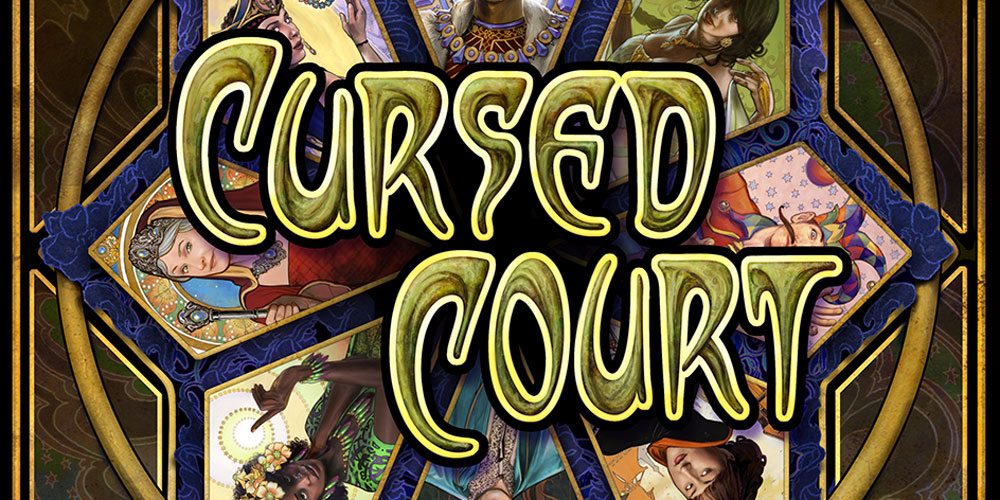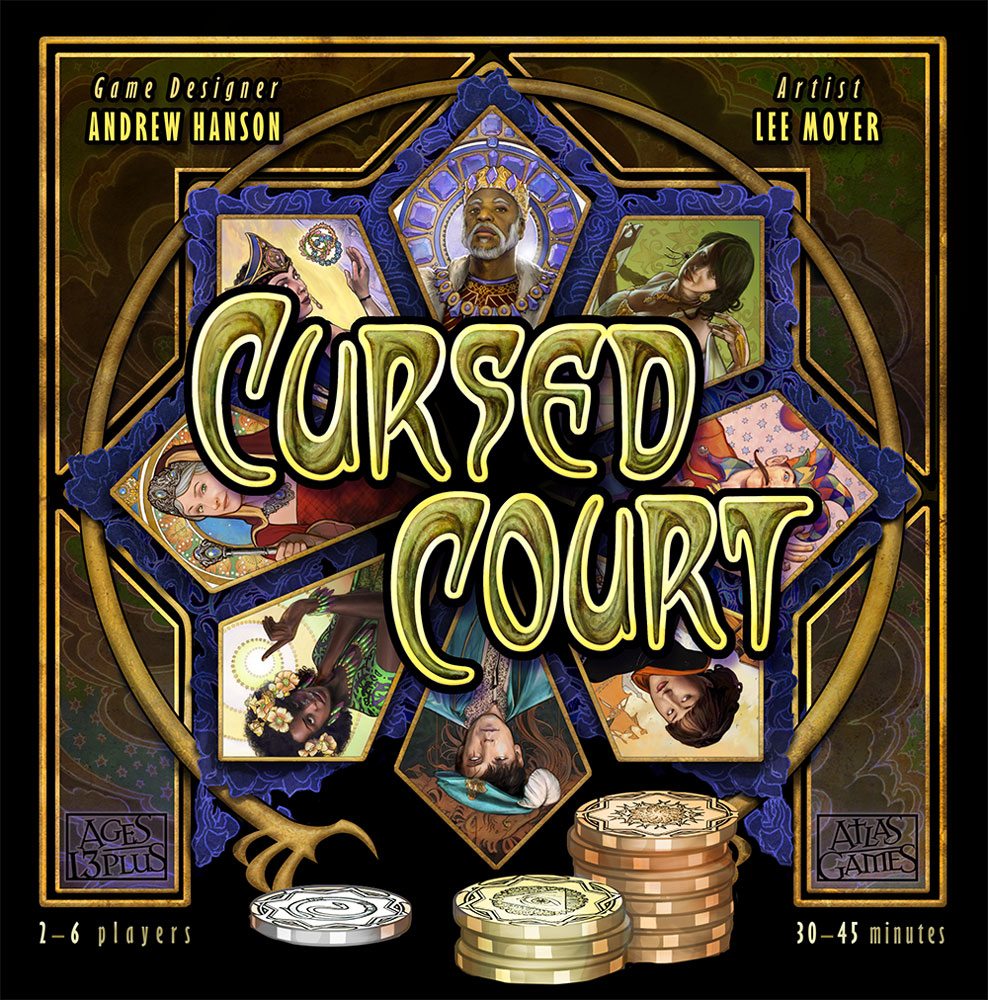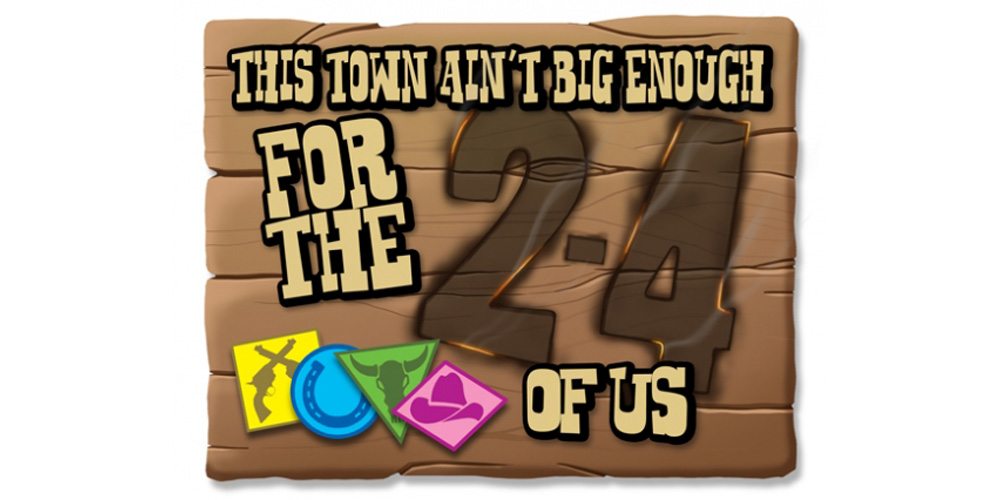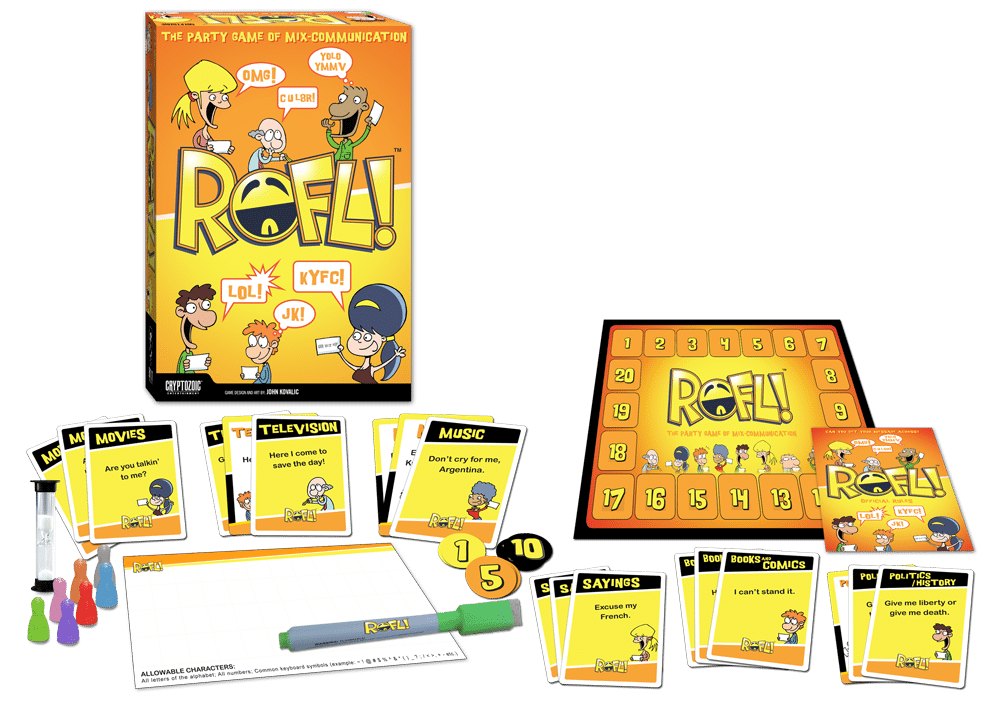The fortunes of the various nobility rise and fall each season, while the minor nobles try to make the most of their limited influence. Hitch your wagon to the right star, and you’ll find yourself in favor in this Cursed Court. Winter, as they say, is coming.
What Is Cursed Court?
Cursed Court is a wagering and deduction game by Andrew Hansen for 2 to 6 players, ages 14 and up, and takes about 30–45 minutes to play. It retails for $49.95; you can pre-order it online, or look for it on store shelves by mid-December. Although the box says 14 and up, I’ve played with kids as young as 8—the rules are not too difficult to learn, though the deduction and bluffing part may be trickier for younger players. (Note for parents: one of the characters pictured in the court is the Courtesan, so you might want to be prepared with an explanation, though the character is equivalent to the others in the gameplay.)
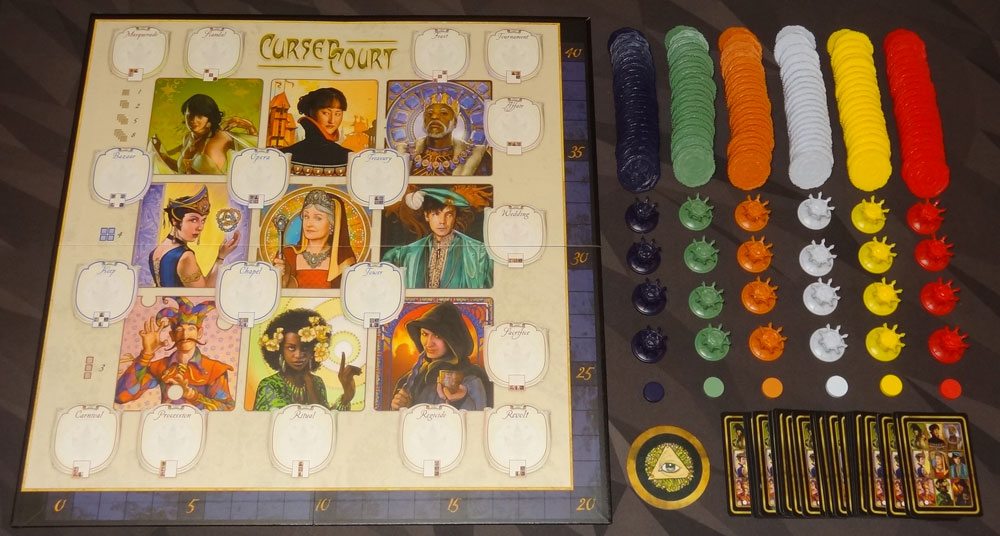
Cursed Court Components
- 24 wagering crowns (4 each in 6 colors)
- 120 Influence coins (20 each in 6 colors)
- 6 score markers
- 36 Noble cards (4 each of 9 nobles)
- First Player token
- Game board
The wagering crowns and influence chips are plastic and look pretty nice, though they aren’t without issues. The coins are fairly lightweight plastic chips and have a floral design on one side and a snake on the other, with patterned edges. (Oddly, the coins on the cover image have the same snake design but the other two images shown are not on the actual coins.) The chips don’t interlock when stacked, and there are just enough of them that if you try to pick them up out of the box in a single stack, they tend to spray out everywhere and make a mess. Trust me: just pick up half at a time.
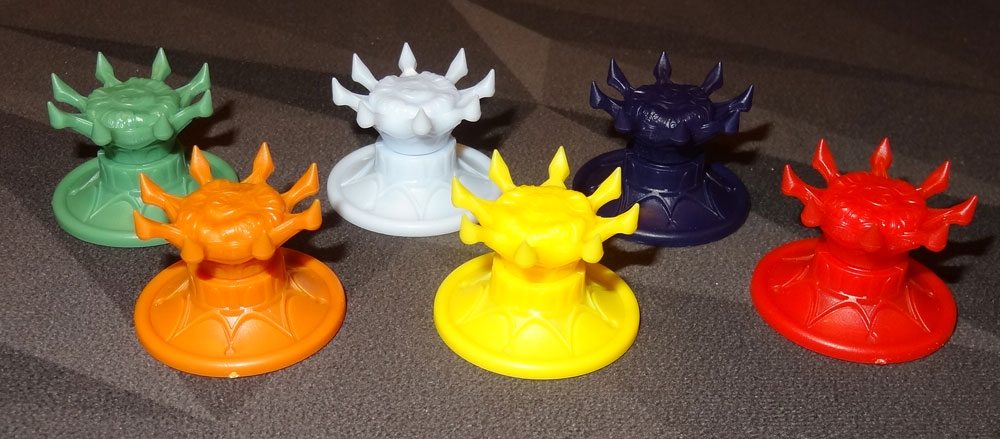
The crowns are pointy crowns on a round base, and those points are sharp. Like, you might be able to draw blood if you smacked one really hard—it was surprising to me that they weren’t dulled down for some sort of safety regulations, but as long as you use them as intended you should be fine.
Atlas Games has actually released the STL files for the components, in case you want to try your hand at printing them out yourself.
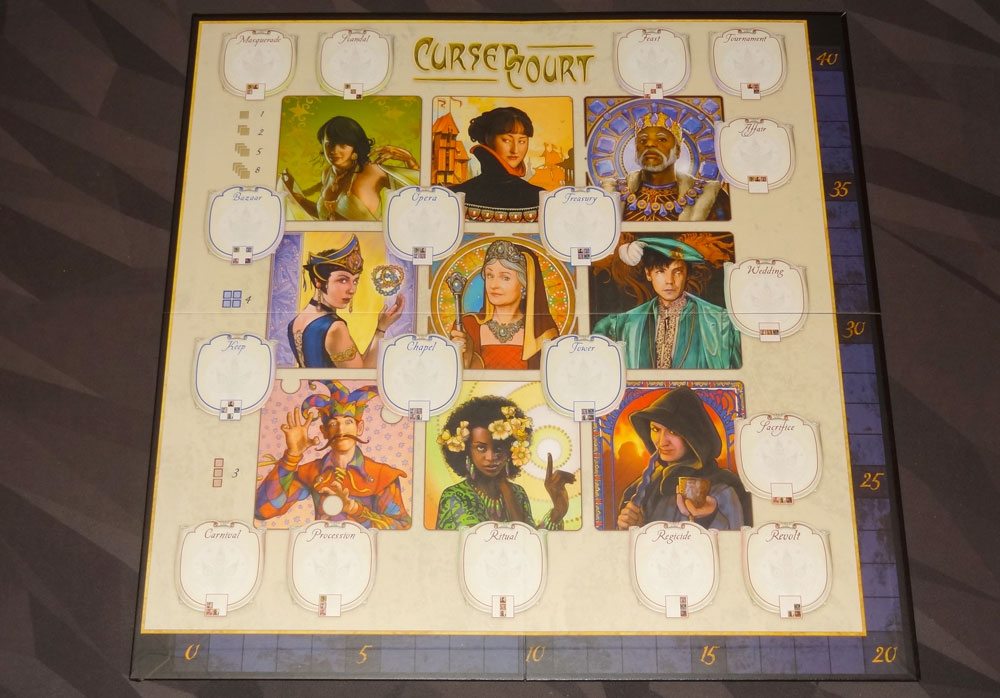
The artwork for the nobles was done by Lee Moyer in an art nouveau style that looks really gorgeous. (Disclosure: I’ve gotten to know Lee in the past few years and he occasionally attends my game nights, so I may be biased.) Lee has a keen eye for detail and is always quite picky about game interfaces, particularly the way the artwork is presented, and he did the layout and design of the game board as well, which shows portraits of the nine nobles, along with various medallions showing particular sets of nobles. The grid of nobles is offset by the score track, which runs along two sides of the board, and Lee showed me how that prevented the Queen (in the center of the board) from having the intersection of the two folds cutting straight through the middle of her face.
The one odd thing to me about the board is that the characters’ titles don’t appear on the board. They’re named on the cards, but on the board they just have the portraits. It isn’t that important for gameplay, since all you really need to know is the location of each character, but since they all have titles, it seems strange not to include them.

The box insert is well designed—there are spaces for the chips, a well for the crowns, and then a spot for the cards, with space underneath them for the scoring tokens (in case you don’t want to just throw them in the space with the crowns).
Overall, the component quality is quite nice; Atlas Games has done a fine job with it.
How to Play Cursed Court
You can download a copy of the rulebook here.
The Goal
The goal of the game is to score the most points over three “years” (rounds) by betting on which nobles will appear in the tableau.

Setup
Give each player the four crowns and 20 coins in their color. Place the board in center of the table, with each player’s scoring chip at the 0 space. Shuffle the cards, and place one face-down between each pair of players. Each player may secretly look at the two cards adjacent to them. Set the rest of the cards nearby. Choose a random player to take the first player marker.
Note: in a 2-player game, instead of dealing cards face-down between the players (in which case both players would know the same information), each player gets two cards face-down to themselves.
Gameplay
The game takes place over three “years,” and each year lasts four “seasons.”
Each season, players will take turns placing bets on the board until everyone has placed a crown. Then, a card is revealed from the deck, the first player marker is passed clockwise, and a new season begins. The year ends after the card is revealed in the fourth season, at which point all of the face-down cards are also revealed, and then players score.
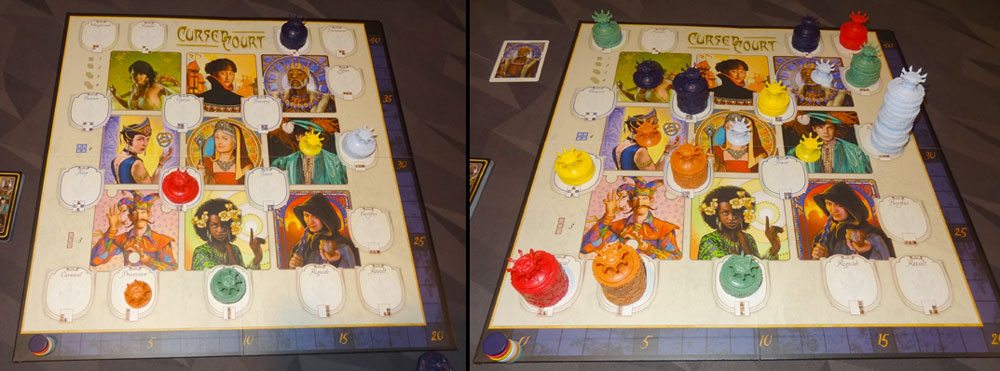
Place Bets
To place a bet, you put a crown, along with any number of your coins, on one of the spaces on the board. You can bet on a specific noble by putting your bet on the portrait, or you can bet on a set. The medallions around the board—with names like “Regicide” and “Chapel” and “Carnival”—each show a particular pattern of three or four nobles. For instance, you can bet on any of the columns or rows, or the four corners, or the three nobles adjacent to one corner.
Oust a Bet
You can also bump another player’s crown by placing at least double the number of coins under your crown. (It costs a minimum of one coin to bump a player’s crown with no coins under it.)
Season End
The season continues, skipping over players who already have the right number of crowns on the board, until everyone has the same number (equal to the season). So if your crown gets bumped, you’ll take another turn, but if you placed a crown this season and none of yours have been bumped, you will pass when your turn comes around. At the end of the season, reveal the top card of the deck and place it into a tableau next to the board. (It’s helpful to arrange the cards so they match the position of the nobles on the board.)

Year End and Scoring
After all four seasons, the year ends. (Note that nobody will be able to place more bets after the fourth card is revealed.) Reveal all of the face-down cards and add them to the tableau.
To score points for a noble, you just need at least one of their cards to turn up. Your score is based on how many of the noble’s cards are revealed: 1, 2, 5, and 8 points, respectively.
To score points for a set, all of the nobles in that set must be revealed—the number of each does not matter. You score 3 points for each 3-noble set and 4 points for each 4-noble set. If any of the nobles in the set were not revealed, you score nothing.
Note that your score is based simply on the crown and the cards that turned up—the number of coins you spent does not affect the score at all.
Game End
After each year is over, all of the crowns and coins are cleared from the board and returned to their owners. All of the noble cards are returned to the deck and reshuffled, and the game is set up for another year.
The game ends after 3 years; the highest score wins. (In case of a tie, you can play additional years until the tie is broken, or just declare a tie.)
Variant Rules
There are a number of variant rules you can introduce to mix things up a little.
The Court Remembers
At the end of the first year, do not shuffle the revealed cards back into the deck; at the end of the second year, shuffle only the first year’s cards back into the deck. You may decide as a group whether to let people look at the left-out cards or not.
The Coinless Court
Do not use coins for betting. Instead, there is no bumping—players may share betting spaces, but you may not bet more than once on the same space. Keep track of the order that bets were placed in each region (either by position or with coins)—players will score one less point for each crown that was placed before theirs.
The Great Exchange
You’ll need a set of poker chips for this variant. Give everyone chips worth 100 points at the beginning of the game. During scoring, chips on spaces that did not score aren’t removed and returned to their owners. Instead, the player who scored the most points during the year takes all of the chips placed on the board that year. (Crowns are still returned to their owners.)
Play continues until only one player has chips remaining.
The Royal Masquerade
This version can be combined with the others, and requires marking the bottom of one crown of each color, making it a “feint.”
You place your feint as you would a normal bet, but it doesn’t score at the end of the year. The feints (and coins with them) are simply returned to their owners at the end of the year, and are used to mislead other players.
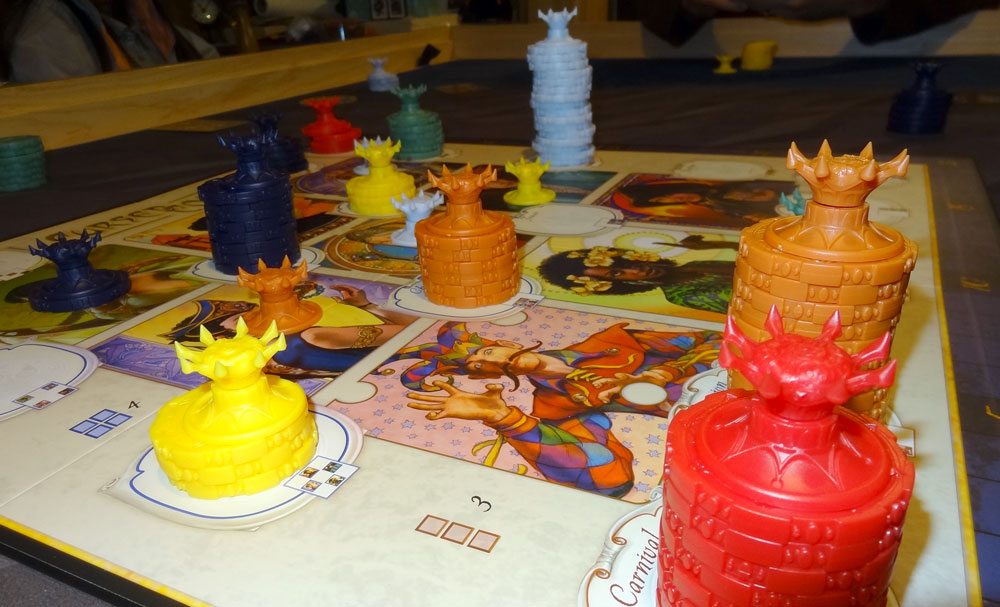
Why You Should Play Cursed Court
Cursed Court is an entertaining mix of bluffing, gambling, and power struggles. The game itself, boiled down to its mechanics, is actually fairly simple—you could just as easily play it with a grid of numbers instead of the lavishly illustrated portraits, but of course it wouldn’t look nearly as great on your table. The theme—spending your influence to wager on which nobles will rise to power from year to year—feels only loosely connected to the gameplay, but none of the people I played with really minded that. I did get some questions about why the court is “cursed,” but honestly I’m not entirely sure.
I like the way that the game uses partially shared information: you and your neighbor both know the same piece of information, but you also each have a piece of information that the other one doesn’t. When you place your crowns, you can go for the sure bets—the cards that have already been revealed or the ones that you’ve looked at—or you can take a chance on a set that hasn’t been confirmed yet. Or, of course, you can bluff, betting on a set of nobles that may lead one or the other of your neighbors to think you’ve seen something you haven’t.
As with most bidding games, knowing how much of your limited resources (influence, in this case) to spend on any particular wager is a key part of the strategy. Since you have to double an existing wager to replace it on the board, the bets can get very expensive very quickly. But how much is 1 guaranteed point worth? What about 3 points? If you spend 11 of your coins on a single crown (so that it’s impossible for anyone to bump you), you won’t have much left for your other three crowns, which means you may get stuck taking spaces that aren’t worth anything at all. It feels great when you force somebody to spend a whole lot of coins to bump you from a spot that you were bluffing about, but not so great when they take a spot that you know is valuable using more coins than you can afford to replace.
There’s also the gambling aspect: how many cards of a set do you need to see before you decide it’s worth a bet? Sometimes making a risky gamble early on can really pay off, if you get your coins on a space before anyone else thinks it’s a possibility. But sometimes it means you’re stuck with all your coins tied up because nobody will bump you from a worthless spot. I’ve seen some last-minute wild guesses that paid off, and I’ve seen a lot of players fighting each other over positions that ultimately didn’t pay out at all.
It’s interesting that the number of coins you spend has nothing to do with the payout, which makes it unlike many betting games. In fact, the coins are only used for the area control—the payouts are the same regardless. It often takes players a round before they really start to grasp the implications of that, but it’s not too difficult to pick up.
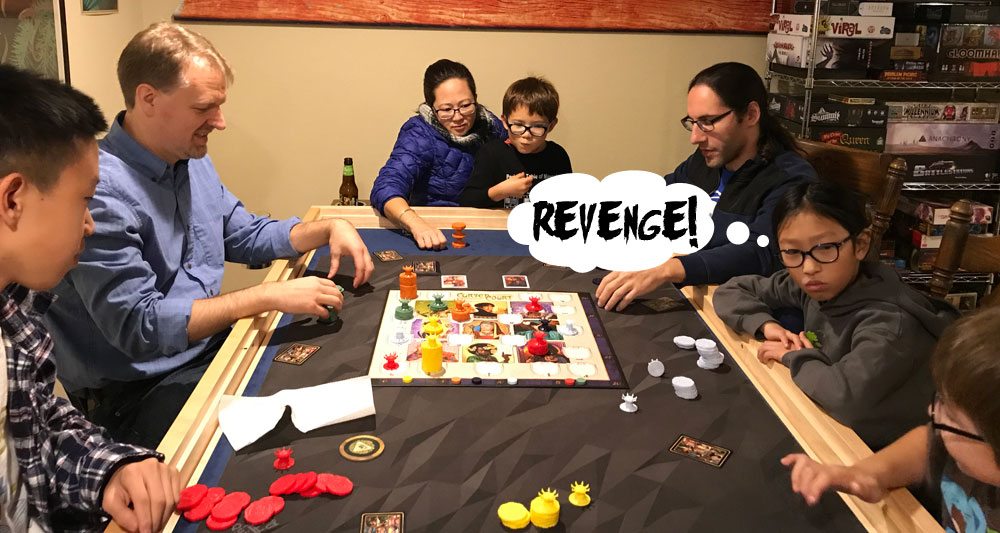
I’ve played Cursed Court with both kids and adults (separately and simultaneously) and I’ve found that it works well with a wide range of ages. There’s enough luck involved in the cards that are revealed that inexperienced players can occasionally get lucky, but there’s also some deduction involved, and the social interaction of figuring out whether somebody is bluffing or not can be a lot of fun. The kids I’ve played with particularly tend to hold grudges when getting bumped, so you’ll see a lot of coins start flying back and forth in bigger and bigger stacks, even for positions that haven’t been confirmed yet.
The one version I didn’t care for as much was the two-player version. You don’t have any shared information—it’s just two cards for you and two for your opponent, plus the four cards that will be revealed over the four seasons. I feel like with only 8 crowns on the board, it’s too easy to spread out and not try to bump each other in many instances, and if you try bluffing with one of your crowns, there aren’t as many players to take the bait so you can get your crown and coins back for your real wager. For me, I think Cursed Court is best with a lot of players, just because it can get a bit more chaotic and competitive.
Overall, I think Cursed Court is an excellent bidding/bluffing game. It’s easy to learn, plays fairly quickly, and looks great on the table. The theme felt like it wasn’t entirely integral to the gameplay, but it was just enough to add some flavor to what is mostly an abstract game. If you like bidding games and fancy artwork, you might want to pay this Cursed Court a visit!
Click here to see all our tabletop game reviews.
If you’d like to stay up-to-date with all of our tabletop gaming coverage, please copy this link and add it to your RSS reader.
Disclosure: GeekDad received a copy of this game for review purposes.
